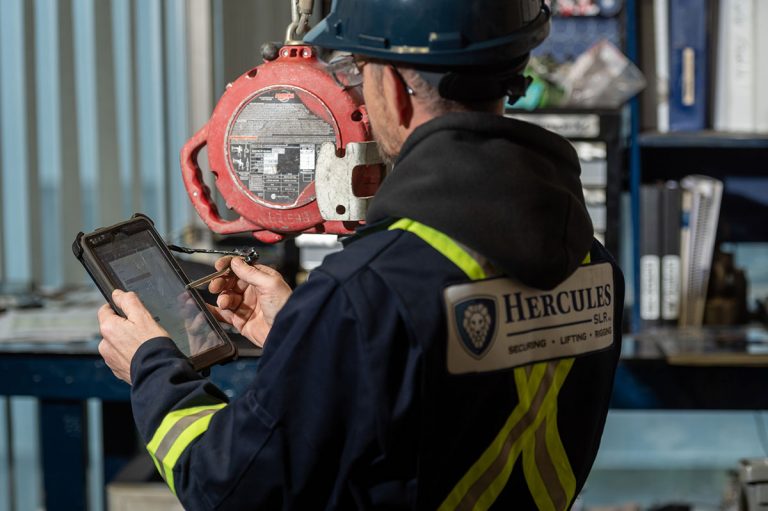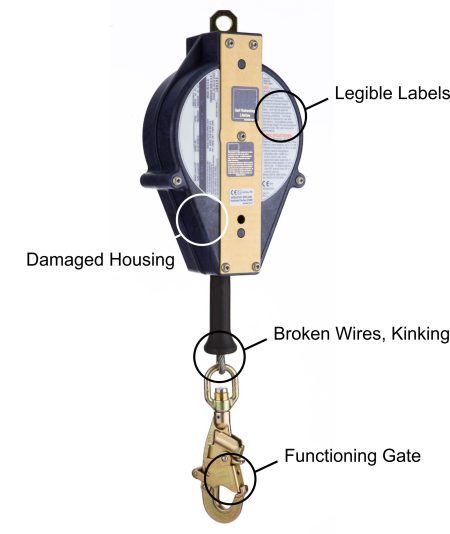Self Retracting Lifeline Service
Comprehensive Services for Self-Retracting Devices: Inspection, Testing, Maintenance, and Certification
 According to Canadian Law, self-retracting devices must be inspected and certified every year. Hercules SLR provides ASME certified inspection, testing, and certification services for self-retracting devices.
According to Canadian Law, self-retracting devices must be inspected and certified every year. Hercules SLR provides ASME certified inspection, testing, and certification services for self-retracting devices.
Self retracting lifeline inspection includes checking for damage and distortion, and checking the functionality of the safety locking mechanism. The technician also checks that all the labels are present and legible, and checks to see if the energy absorber has been activated. Energy absorbers that have been activated must be removed from service and destroyed.
Nothing is more important that going home safe at the end of the day, so make sure your self retracting device maintenance is up to date.
Contact Hercules SLR today.
Self-Retracting Lifelines devices

Frequently Asked Questions
How often must self retracting devices be inspected?
According to Canadian Law, self-retracting devices must be inspected and certified every year. As the equipment owner, you are responsible to establish a revalidation timetable for your SRLs. Manufacturers frequently advise customers on the best time between recertification’s. CSA 259.2.2-17 has added categories in Table 2 to assist in determining the appropriate time schedule. That time frame being between 1-5 years.
Common signs of wear on self retracting devices?
Common signs of wear including, but not limited to, corrosion, deformation, pits, burrs, rough surfaces, sharp edges, cracking, rust, excessive heating, and alteration.
If SRL fails inspection at any time it must be immediately removed from service and either destroyed or returned to the manufacturer for repair.
What are Self-Retracting Devices inspection?
Servicing and inspection of mechanical fall protection devices, such as Self Retracting Devices (SRDs) often referred to as Self Retracting Lifelines (SRLs) or Lanyards are important requirements of any effective fall protection safety program. The frequency of servicing and inspection as well as who should perform these activities are critical items. All fall protection equipment, including SRDs, must be inspected before each use. If inspection reveals a defective condition, the SRDs must beremoved from use and repaired/ serviced.
Canadian Standards Association (CSA) standard CAN/CSA Z259.2.2-17 requires SRD’s to be returned to the manufacturer or manufacturer-approved agent no more than 2 years after the date of manufacture for inspection and maintenance and annually thereafter.
A self-retracting lanyard, personal (SRL-P) is worn by the user on a full-body harness to be used as a fall arrest connector.
Self-retracting lifelines (SRLs) are hugely important for preventing injuries and fatalities from falls in the workplace. They attach to the D-ring of the safety harness and lock to stop the worker from freefalling too far in the event of a fall from height and reduce the likelihood of a swing fall. Some SRLs even provide a deceleration device to slow the fall of the body harness or offer a shock absorber effect that slows the fall down over a short distance, usually up to three and a half feet.
ANSI 359.2 requires formal inspection of all fall protection equipment by a Competent Person. More frequent inspections may be necessary depending on the nature of the work environment, frequency of SRL use, and other manufacturer recommendations.

